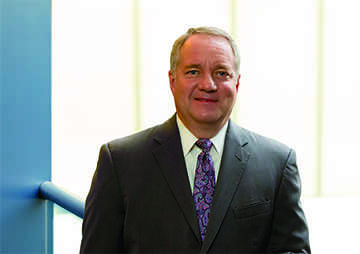 Adam Hamilton, P.E., President & CEO
Adam Hamilton, P.E., President & CEO For more than 70 years, Southwest Research Institute has pushed the boundaries of scientific and engineering applications by continuing to innovate as we fulfill our mission for the benefit of our clients and all humankind. Our multidisciplinary, client-focused approach to solving critical technical challenges in environments from Deep Sea to Deep Space® has guided us through another successful year.
I am pleased to present the 2018 Annual Report, which highlights some of our accomplishments, made possible by our time-tested approach, and summarizes the Institute’s improved financial performance in Fiscal Year 2018.
Our FY18 financial performance was much improved because of the hard work and dedication of our staff. Additional emphasis on enhancing our business development practices, using collaborative teams to grow into new markets and offer expanded capabilities to existing clients, and our added attention to cost controls are largely responsible for the notable fiscal improvements. In addition, the relatively healthy macroeconomic conditions and the recovery of the oil and gas marketplace also contributed to our financial success. The combination of staff efforts and these favorable economic conditions allowed us to grow our research revenue by more than 10 percent to $583.7 million and produce a net income (net assets at the end of the year) of $38 million.
While our financial performance is important and financial success is paramount to our sustainability, our pride in the Institute is tied to the programmatic success and technical contributions that we make to the national and international communities. Our technical staff sought collaborative research opportunities, both within the Institute and with other organizations, as we grew our technical programs in FY18. This year, we were awarded several U.S. government contract mechanisms including an indefinite delivery/indefinite quantity contract spanning chemical, biological, radiological and nuclear defense laboratory projects.
Also in 2018, we broke ground on a novel pilot-scale super-critical carbon dioxide (sCO2) electric power generation plant to demonstrate high efficiency, lower emissions, and lower-cost benefits of this new technology. We extended a 20-year agreement with the Central Research Institute of Electric Power Industry in Tokyo, Japan, to provide technology, research and development services to the Japanese power industry. These include evaluating fire hazards at nuclear facilities; creating advanced technology for safe and efficient electric power generation, storage and distribution; developing advanced combustion cycles; and designing smart grid technology.
Meanwhile, we joined the University of Texas at San Antonio in a project to develop a 3D-printed implant to deliver various therapeutics to treat diseases, and another to develop DNA-based tracers to characterize the recharge and flow patterns in the Edwards Aquifer, San Antonio’s source of drinking water.
We invested in a number of infrastructure projects to better support our clients and enable our researchers to expand their expertise and offer new capabilities. Engineers in our new Collaborative Robotics Laboratory used deep-learning algorithms, perception technologies and advanced path planning tools to develop collaborative robots, called “cobots,” that work safely alongside humans to perform multiple complex tasks.
We opened our Energy Storage Technology Center® laboratory, which gives us more capacity and flexibility to perform leading-edge research on battery performance and characterize next-generation energy storage and enhanced vehicle electrification. To meet international health concerns over solid particle emissions, our fully accredited particle emissions laboratory was qualified to calibrate equipment to ISO/IEC 17025 standards.
The Institute invested nearly $7 million in internally funded research to advance our technology base and allow technical staff to explore innovative concepts and extend their reach. Many of these projects are detailed throughout this report.
We take pride in being good corporate neighbors. Staff members mentor students in science, technology, engineering and math (STEM); serve as judges at collegiate and high school STEM competitions; and speak at numerous community outreach activities. Meanwhile, they advance science and technology through peer-reviewed papers, presentations, patents and other activities.
Many SwRI staff members sit on boards and committees of industry and professional groups seeking to set industry standards and advance scientific innovation. Others are active in the local community supporting the food bank, delivering meals to seniors, contributing to United Way agencies, and much more. This year, Forbes Magazine named the Institute one of the 500 “America’s Best Workplaces” among midsize employers with 1,000 to 5,000 employees. In addition, the Institute continues to be a major economic contributor in San Antonio, contributing more than $1 billion to the local economy.
While the coming year brings with it new challenges, a healthy backlog of contracts will likely make FY19 another successful year with proposals and follow-on research pointing to even more new opportunities. We remain committed to being the first choice for clients seeking solutions for their most complex problems. I am grateful to our Board of Directors for their dedication, to our Board of Advisory Trustees for their valued advice, and to the technical and administrative staff for their hard work and support. Together we will ensure that our clients receive the highest quality scientific and technical services in 2019 and beyond.
